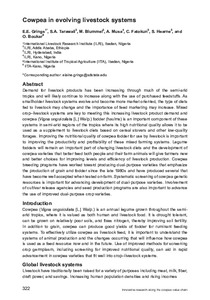Welcome to the International Institute of Tropical Agriculture Research Repository
Cowpea in evolving livestock systems
| dc.contributor.author | Grings, Elaine E. |
| dc.contributor.author | Tarawali, Shirley A. |
| dc.contributor.author | Blümmel, Michael |
| dc.contributor.author | Musa, A. |
| dc.contributor.author | Fatokun, C.A. |
| dc.contributor.author | Hearne, S. |
| dc.contributor.author | Boukar, O. |
| dc.date.accessioned | 2019-12-04T10:57:03Z |
| dc.date.available | 2019-12-04T10:57:03Z |
| dc.date.issued | 2012-12-31 |
| dc.identifier.citation | Grings, E.E., Tarawali, S.A., Blümmel, M., Musa, A., Fatokun, C., Hearne, S. and Boukar, O. 2012. Cowpea in evolving livestock systems. IN: Boukar, O., Coulibaly, O., Fatokun, C.A., Lopez, K. and Tamò, M. 2012. Innovative research along the cowpea value chain: Proceedings of the Fifth World Cowpea Conference on Improving livelihoods in the cowpea value chain through advancement in science, held in Saly, Senegal, 27 September -1 October 2010. Ibadan, Nigeria: IITA: 322-333. |
| dc.identifier.isbn | 978-978-8444-07-7 |
| dc.identifier.uri | https://hdl.handle.net/20.500.12478/568 |
| dc.description.abstract | Demand for livestock products has been increasing through much of the semi-arid tropics and will likely continue to increase along with the use of purchased feedstuffs. As smallholder livestock systems evolve and become more market oriented, the type of diets fed to livestock may change and the importance of feed marketing may increase. Mixed crop–livestock systems are key to meeting this increasing livestock product demand and cowpea (Vigna unguiculata [L.] Walp.) fodder (haulms) is an important component of these systems in semi-arid regions of the tropics where its high nutritional quality allows it to be used as a supplement to livestock diets based on cereal stovers and other low-quality forages. Improving the nutritional quality of cowpea fodder for use by livestock is important to improving the productivity and profitability of these mixed farming systems. Legume fodders will remain an important part of changing livestock diets and the development of cowpea varieties that better feed both people and their farm animals will give farmers new and better choices for improving levels and efficiency of livestock production. Cowpea breeding programs have worked toward producing dual-purpose varieties that emphasize the production of grain and fodder since the late 1980s and have produced several that have become well accepted when tested on-farm. Systematic screening of cowpea genetic resources is important for advancing development of dual-purpose varieties. Involvement of cultivar release agencies and seed production programs are also important to advance the use of improved dual-purpose crop varieties. |
| dc.language.iso | en |
| dc.publisher | IITA |
| dc.subject | Livestock |
| dc.subject | Crops |
| dc.title | Cowpea in evolving livestock systems |
| dc.type | Book Chapter |
| cg.howpublished | Grey Literature |
| cg.accessibilitystatus | Open Access |
| local.dspaceid | 34576 |


